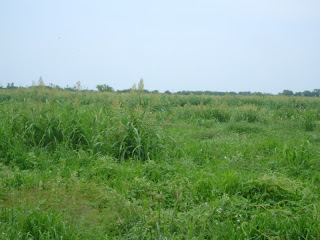MALEZAS RESISTENTES AL GLIFOSATO
MALEZAS RESISTENTES: UN AVANCE IMPARABLE EN TODAS LAS REGIONES (de un artículo en La Nación, Campo, Ene.18, 2013) ENGLISH VERSION BELOW
Image: agrotestigo.crowdmap.com Lote
abandonado por alta infectacion de sorgo resistente al glifosato.
En la
Argentina, el primer caso de resistencia a herbicida fue en 1996. Fue en amaranthus quitensis, resistente a
imazethapyr con resistencia cruzada a herbicidas inhibidores de ALS (*). Después
de ese caso, en 2005 se registró sorgo de
alepo resistente a glifosato. Según consignan los técnicos, desde ese
momento, todos los años y en diferentes regiones fueron apareciendo nuevas
malezas problemáticas, como lolium
multiflorum y lolium perenne en
el sur y norte de Buenos Aires y sur de Santa Fe. Además, surgió echinocloa colona en Santa Fe y Tucumán,
cynodonhirsutum en el centro de
Córdoba. Mientras tanto, está bajo estudio amaranthus
quitensis en Tucumán y Santiago del Estero.
"Las
malezas resistentes a herbicidas ya están instaladas en nuestro país. Dependerá
de nosotros los cambios a realizar para que este impacto sea menor…”, dicen los
técnicos del INTA Río Primero y del INTA Manfredi en el informe realizado sobre
las malezas resistentes.
(*) ALS o
AHAS: herbicidas que actúan sobre enzimas específicas para prevenir la
producción de aminoácidos.
N. del E.:
Evidentemente, cuando las malezas habituales son eliminadas por los herbicidas
sintéticos, otras ocupan su lugar y, por una simple razón de adaptación
biológica, las que se instalan en el lugar que dejaron las anteriores son
resistentes a los herbicidas que provocaron el cambio. Los técnicos aconsejan
una serie de medidas preventivas; casi todas ellas responden a un protocolo de
limpieza y a evitar la diseminación de las semillas indeseables. Pero no dejan
de aconsejar el uso de herbicidas diferentes o en coordinación con el glifosato.
Será que estamos llegando a un momento en que la forma de combatir las malezas
resistentes sea no obstruyendo el desarrollo de las tradicionales que el hombre
de campo argentino manejó desde antaño sin necesidad de herbicidas sintéticos?
----------------------------------------------------------------------------------------------------------------------------------------
RESISTANT WEEDS: UNSTOPPABLE ADVANCE IN ALL REGIONS (from an article in La Nación, Campo, Jan.18, 2013)
Image: agrotestigo.crowdmap.com Abandoned
lot due to high infestation of glyphosate resistant sorghum.
In Argentina, the
first case of an herbicide resistant weed was in 1996. It was amaranthus
quitensis, resistant to imazethapyr with crossed resistance to ALS (*) inhibiting
herbicides. After this case, in 2005 it
was recorded a glyphosate resistant sorghum alepensis. As recorded by the
technicians, after that time every year and in different regions new
problematic weeds appear, such as lolium multiflorum and lolium perenne in the
South and North of Buenos Aires province and south of Santa Fe. Besides, echinocloa
colona emerged in Santa Fe and Tucumán, and cynodonhirsutum in the center of
Córdoba province. Right now, amaranthus quitensis is under study in Tucumán and
Santiago del Estero.
"Herbicide resistant
weeds are already installed in our country” say technicians of INTA Rio Primero
and INTA Manfredi in a report on resistan tweeds. “It depends on us to set up
the changes that diminish the impact …”,
(*) ALS or
AHAS: herbicides that act on the specific enzymes that prevent aminoacid
production.
N. of the
E.: Evidently, when the traditional weeds are eliminated by the synthetic
herbicides, others occupy their place and, for a simple reason of biologic
adaptation, those that set up in the place the others left are resistant to the
herbicides that caused the change. Technicians recommend a number of
preventative measures; almost all of them respond to a cleaning protocol and
forms to avoid spreading of the undesirable seeds. But they do not stop
recommending the use of different herbicides alone or in combination with
glyphosate. Let’s ask ourselves: wouldn’t it be arrived the time to consider
that the way to combat resistant weeds may be not obstructing the development
of the traditional weeds that our farmers managed in the old days without the
need of synthetic herbicides?

Comentarios
Publicar un comentario